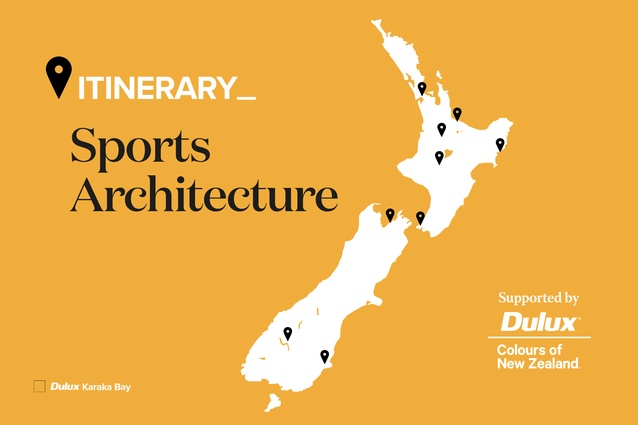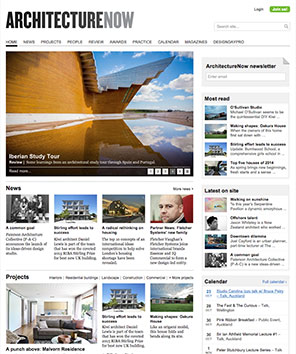Itinerary: Sports architecture
In this month’s Itinerary, supported by Dulux Colours of New Zealand, Andrew Barrie highlights 14 projects with significant ties to New Zealand’s sporting culture.
We like to think of ourselves as a sporting nation. Glories are fleeting but, as I write, Kiwis are basking in the glow of the retention of the America’s Cup, All Blacks’ wins over Australia and England, a test cricket series sweep in India, and our netball team claiming the Constellation Cup. Hoorah! Unsurprisingly, we value our sports architecture — it is telling that the first major public facility replaced after the Christchurch earthquakes was the rugby stadium.
But surveys show participation in organised sport is declining and, as with many of our traditional community institutions, many sports clubs are struggling to maintain their viability. In contrast to this slow decline, spectatorship is thriving. The professionalisation of rugby in the 1990s created demands for commercialisation and branding, and sports grounds became key aspects of image and revenue generation. Many types of sporting venues transitioned from primarily supporting individual improvement and community interaction to the provision of commercial experiences and, eventually, as ticket prices accelerated upwards, to spectatorship as a luxury good — a world of VIP packages, private lounges, exclusive experiences and other expensive, architecture-enabled add-ons. Servicing these new demands, particularly where they intersected with those of entertainment events, has been a key driving force behind the emergence of a new generation of sports venues over the last 20 years.
Venues, like teams, often have symbolic importance to their local communities. Mercifully, we’ve so far avoided the American situation where professional, privately owned sports teams leverage this emotional connection and threats of leaving to force municipalities into providing ostentatious facilities. We have, however, seen a parade of extravagant schemes for a new national stadium on or near the Auckland waterfront. It’s become a kind of informal, slow-motion design competition. This should raise red flags, especially given how poorly we often run even formal design competitions; we tend to employ them only for large, high-stakes projects, without our having accumulated expertise — administration, judging, minimising political shenanigans — through lower-stakes competitions.
The bigger projects on this itinerary are, unsurprisingly, the products of our largest firms. Unlike other types of large buildings, sports projects in smaller centres, perhaps because the organisations that commission them are so embedded in their communities, are often picked up by local firms.
Where there is money to be made, or political reputations are at stake, resources are inevitably made available, and big projects get done. The problems such projects address tend to be those of technical resolution and urban form. However, the smaller projects by local firms have been some of our most innovative and inspiring of recent years. Naenae Bowling Club is an example of how social, financial and architectural ingenuity have intersected. A bowling club sold its valuable site, combined with another club in a run-down part of town, and boldly developed a world-class facility that has drawn in people and events to the extent that it has boosted not just club membership but surrounding businesses — a grassroots Guggenheim Effect.
We find ourselves in a moment when resources are being withdrawn from community-level interventions in favour of projects ‘of national significance’. In the absence of a sprinkling of Ministerial fairy dust, the hurdles for grassroots projects are rising, but if architects can contribute the time necessary to help organisations surmount obstacles, we can be optimistic about both the health of our communities and the sporting glories of the future.
THE ITINERARY
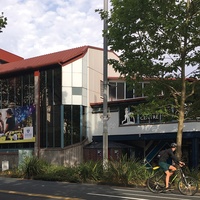
01. 1977 – Recreation Centre
University of Auckland, 17 Symonds Street, Auckland
JASMaD
Among the most celebrated buildings of its era, it won a host of awards, including the NZIA National Award and Gold Medal in 1979 and an Enduring Architecture Award in 2003. So as not to dominate the then adjacent student union and houses, the large gym was partially buried to reduce its apparent volume, many facilities were located below ground, and support spaces were housed in informal lean-to structures around two sides. The building was demolished in 2021; the University also recently razed JASMaD’s Silver Medal-winning, DoCoMoMo-listed International House (1971). See NZ Architect no. 1, 1979, and no. 3, 1979.
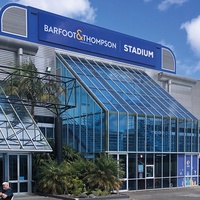
02. 1989 – Chase Stadium
203 Kohimarama Road, Kohimarama, Auckland
Dodd Paterson Architects
Now named Barfoot & Thompson Stadium, this hi-tech confection was built on the grounds of Selwyn College. Initially intended as a relatively modest school gymnasium, it was expanded to become the gymnastics venue for the 1990 Commonwealth Games. See Architecture NZ Mar/Apr 1988. The 1990 games broke new ground, architecturally. Expectations for sporting events had been reset by the 1984 Los Angeles Olympics — an architecture of commodity and delight over firmness. The athletes’ village and venue dressing, by designers including Bossley Cheshire Architects and KRTA, made extensive use of impermanent materials, such as scaffolding, painted ply and cardboard tubes.
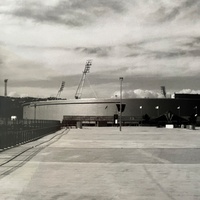
03. 2000 – Wellington Regional Stadium
147 Waterloo Quay, Wellington
Warren and Mahoney
Officially now named Sky Stadium but affectionately known as ‘The Cake Tin’, this stadium replaced the ageing and poorly located Athletic Park. Designed by Warren and Mahoney with Bligh Lobb Sports Architecture, it was the nation’s first bowl stadium and can host cricket, rugby, soccer and entertainment events. Built on reclaimed railway land, it is linked directly to both transport networks and the central city. Its distinctive, sleek metal skin and location on key approaches to the city make it the sports building which has made the strongest contribution to urban form. See Architecture NZ Jan/Feb 2000.
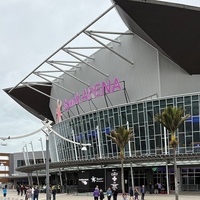
04. 2007 – Spark Arena
Mahuhu Crescent, Auckland
Crawford Architects
The largest of the nation’s indoor arenas, this 12,000-seat multifunctional venue hosts sports such as basketball and netball as well as events from rock concerts to theatrical events to NZIA conferences. Usefully located near the city centre and transport links, the project was one of New Zealand’s first large public-private partnerships; the concept design by American firm Crawford Architects was brought to completion by Peddlethorp Architects. Construction difficulties meant contractor Mainzeal took heavy losses on the project; these likely contributed to its collapse a few years later. The building is now owned by controversial entertainment behemoth Live Nation Entertainment.
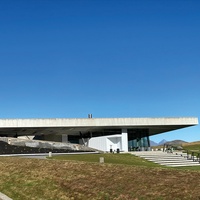
05. 2008 – The Hills Clubhouse
164 McDonnell Road, Arrowtown
Patterson Associates
The project provides clubhouse facilities at The Hills Golf Club, a swanky private golf club developed by jewellery entrepreneur Sir Michael Hill. Firmly embedded into both the ground and the luxury end of the sports architecture spectrum, the building sits in a course peppered with large-scale sculpture. The building was the recipient of a string of awards, including an NZIA Supreme Award in 2008. Bookings required. See Architecture NZ Jan/Feb 2008. Patterson fans with less room on their calendars or credit cards might check out the A J Hackett Kawarau Bungy Centre (2003) nearby, at 1693 Gibbston Highway, Gibbston.
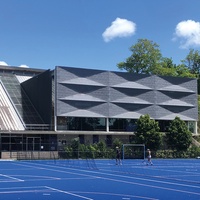
06. 2009 – St Kentigern School Jubilee Sports Centre
82 Shore Road, Remuera, Auckland
Architectus
This is a primary school sports facility, though one of sophistication really available only in private schools, particularly in the current funding environment. The large volume of the gym was buried in a slope between two sports fields, with secondary amenities cleverly arranged above, below and beside. The result is a delicate pavilion edging the upper field, the gym looking out over the lower field, and a vertiginous circulation route linking the lot. Recipient of an NZIA National Award in 2011. See Architecture NZ Jul/Aug 2010. In 2022, Architectus completed two further award-winning buildings on the school site.
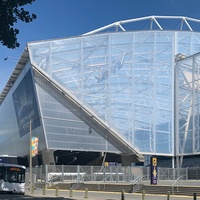
07. 2011 – Forsyth Barr Stadium
130 Anzac Avenue, Dunedin
Jasmax and Populous
One of a number of venues built in time for the 2011 Rugby World Cup, this was the world’s first fully enclosed natural turf stadium and is still the nation’s only covered stadium. It replaced the famed Carisbrook, which had similar capacity and a larger ground. Forsyth Barr’s ground is too small to host cricket, but relocatable seating offers flexibility for a range of events. The value of this exchange has been demonstrated, particularly after Christchurch’s stadium was lost in the ’quakes, with the venue hosting concerts ranging from Black Sabbath to three back-to-back shows by Ed Sheeran. See Architecture NZ Oct/Nov 2011.
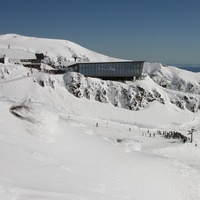
08. 2011 – Knoll Ridge Café
Top of Bruce Road, Mount Ruapehu
Harris Butt Architecture
Located on Whakapapa Ski Field in Tongariro National Park, this project replaced a previous café, destroyed by fire in 2009. It sits in a changing and often extreme context — craggy volcanic rock and climbers in summer, snow and crowds of skiers in winter, freezing temperatures and wind speeds of up to 200kph year-round. Instead of the low-slung, defensive posture usually adopted in the face of tough conditions and heavy use, the project is assertive — a form cantilevered into the view, and an interior animated by a laminated timber structure. Recipient of an NZIA National Award in 2012. See Architecture NZ Jan/Feb 2012.
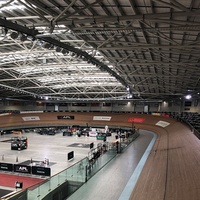
09. 2014 – Avantidrome
15 Hanlin Road, Cambridge
Chibnall Buckell Marovic Team
Now known as the Grassroots Trust Velodrome, this is the headquarters for the national high-performance track cycling programme, as well as a set of other community facilities. Design attention focused on the geometrically complex task of forming the timber-surfaces track while ensuring sight lines for spectators and access for competitors. An adjoining block houses a gym, office and support spaces, some of which double as VIP lounges during competition. Plans are afoot to add a Sports Hall of Fame building in the near future. See Progressive Building Oct 2013. Pop in to see Roy Lippincott’s 1930s buildings at St. Peter’s School next door.
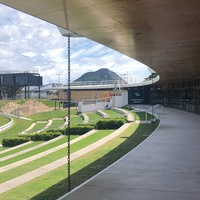
10. 2015 – Bay Oval Trust Carrus Pavilion
Kawaka Street, Mount Maunganui
Jasmax
This ground hosts international games but is enclosed by only a continuous sweep of embankment and some boxes for broadcasters. Jasmax’s pavilion is a crisp arc that simply follows the curve of the field. The embankment out front has been stepped to allow more intensive occupation. Barnaby Bennett wrote that the building succeeded “through careful planning, flexible space and a commitment to making sure [it] performed well, not just during the rare internationals but also for the other 99 per cent of [its] usage”. Recipient of an NZIA Local Award in 2015. See Architecture NZ Mar/Apr 2015. The pavilion is currently being doubled in size.
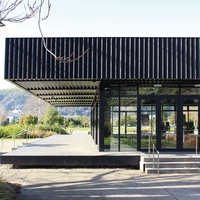
11. 2017 – Trafalgar Centre
Paru Paru Road, Nelson
Irving Smith Architects
As is typical of many municipal sports facilities, the Trafalgar Centre has undergone a series of updates and extensions to accommodate new uses and meet increasing expectations. First constructed in 1973 by Alex Bowman, it was extended by Arthouse Architects in 2009, and a further extension and earthquake strengthening was completed in 2017 by Irving Smith. The recent extension is an unpretentious but useful foyer and gathering space. The clever arrangement and generous glazing of the latest addition allows users to make the most of the adjacent park. The project won an NZIA National Award in 2018. Refer Architecture NZ May/June 2018.
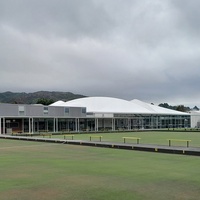
12. 2017 – Naenae Bowling Club
25 Vogel Street, Naenae, Lower Hutt
Tennent Brown Architects
As with other types of community institutions, many sports clubs are struggling. This project came about when two local bowling clubs merged, selling the valuable land holdings of one and using the proceeds to build top-notch facilities on the site of the other. Located with a collection of other community-level sports and recreational facilities but offering facilities intended to entice international-level events, the project has generated the hoped-for growth; membership rapidly expanded such that this is now the largest bowling club in the country. The project received an NZIA National Award in 2020. See Architecture NZ July/Aug 2018
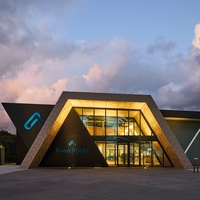
13. 2023 – Kiwa Pools
Centennial Marine Drive, Gisborne
Architecture HDT
Replacing a 1970s pool complex, this project is typical of the new breed of community sports facilities. Low-scaled and sited amongst other municipal recreational amenities, it seeks to maximise year-round amenity and accessibility for all users and form part of a hub for community activity. It includes an Olympic-sized indoor pool, hydrotherapy pool, learn-to-swim pools, a kids’ splash pool and event hire spaces. The structure and services are exposed, and interior adornments by local arts maestro Sir Derek Lardelli provide a sense of cultural resonance and local connection. The project received an NZIA Local Award in 2024.
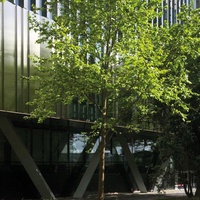
14. 2024 – Recreation and Wellness Centre
University of Auckland, 17 Symonds Street, Auckland
Warren and Mahoney
Comparing the new Centre to the 1977 version aptly illustrates the shifting understandings of sport and wellness across 40-odd years, as well as the elevation of ‘the student experience’ in university life. It will service a university population that has more than quadrupled since the 1970s and which demands a greater range of needs and interests be provided for. In place of JASMaD’s deliberately recessive and modest form-making, the new building is literally flashy — stainless-steel fins and civic-scaled foyers give access to a 10-storey stack of facilities, including a pool, dive well, bouldering wall and ‘chill’ spaces.
OTHER ADDRESSES
1995 –TSB Arena
4 Queens Wharf, Wellington
Craig Craig Moller
Formerly known as the Queens Wharf Events Centre.
1997 – North Harbour Stadium
Stadium Drive, Albany, Auckland
GHD Design
2002 – FMG Stadium Waikato
128 Seddon Road, Hamilton
Peddle Thorp Architects
2004 – The Trusts Arena
65–67 Central Park Drive, Henderson, Auckland
Warren and Mahoney
2007 – Energy Events Centre
Queens Drive, Rotorua
Boon Goldsmith Bhaskar
2010 – Eden Park South Stand
Reimers Avenue, Mount Eden, Auckland
Jasmax and Populous
The nation’s highest-capacity venue.
2011 – Sir Don Rowlands Centre
601 Maungatautari Road, Karāpiro
Chibnall Buckell Marovic and Team Architects
The base for rowing on Lake Karāpiro.
2011 – Ākau Tangi Sports Centre
72 Kemp Street, Kilbirnie, Wellington
Tennent Brown Architects
Originally known as ASB Sports Centre.
2014 – St Cuthbert’s College Centennial Centre for Wellbeing
122 Market Road, Epsom, Auckland
Architectus
2014 – Hagley Oval Pavilion
Riccarton Avenue, Christchurch
Athfield Architects
2015 – Remarkables Ski Field Base Building
Remarkables Ski Field Access Road, Queenstown
Wyatt & Grey Architects
SOURCES
These projects were widely published in contemporary journals. Paul Walker’s critique of Chase Stadium in Architecture NZ (Mar/Apr 1988) paints an interesting picture of sports architecture in the 1980s. The Barnaby Bennett article (Architecture NZ Mar/Apr 2015) on Bay Oval and Hagley Park cricket pavilions quoted above touches on wider issues and rewards seeking out. Peddle Thorp’s Richard Goldie wrote of the international state of play for sports-grounds in ‘Stadia dreams’ in Architecture NZ (Nov/Dec 2019). Many of the firms cited have published monographs — see Stephen Stratford’s Jasmax (Auckland: NZ Architectural Publications Trust, 2007) and New Territory: Warren and Mahoney (Auckland: Balasoglou Books, 2005), Haig Beck and Jack Cooper’s Architectus: Between Order and Opportunity (Berkeley, CA: Oro Editions, 2009), Habits Form Habitats (Wellington: Tennent Brown Architects, 2015), and Aaron Betsky’s Unfinished & Far Far Away: The Architecture of Irving Smith Architects (Barcelona: Altrim, 2023). Some of our venues have stories written up: see John McCrystal and Lindsay Knight, Eden Park: A History (Wellington: Phantom House Books, 2011) and Tim Donoghue, Athletic Park: A Lost Football Ground (Wellington: Tim Donoghue Publications, 1999).

The Itinerary series is supported by Dulux Colours of New Zealand. Dulux Colour Specialist Davina Harper has selected a Colours of New Zealand palette based on this itinerary. See the full range and order colour samples here.


